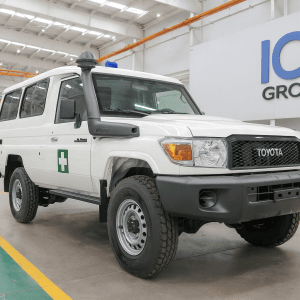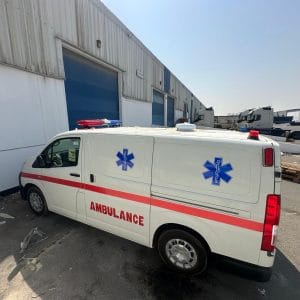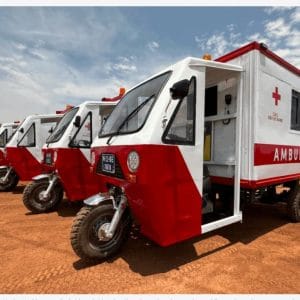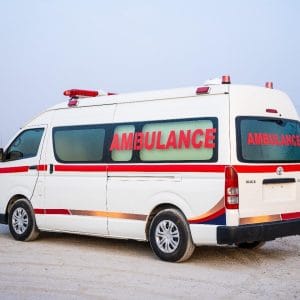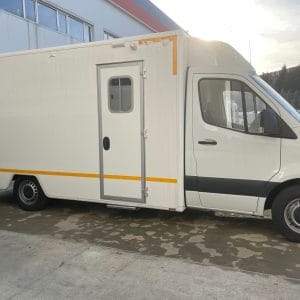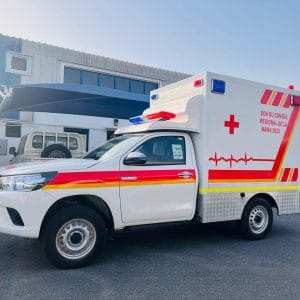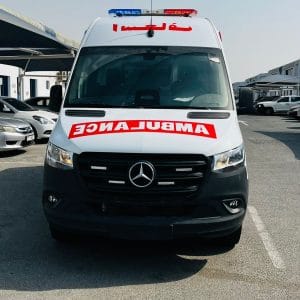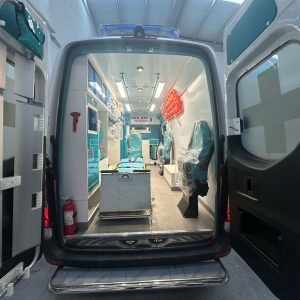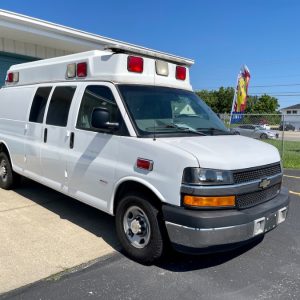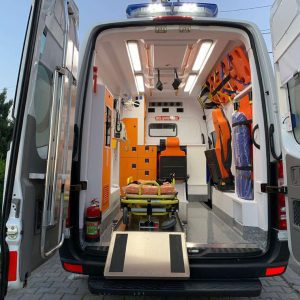1. Introduction
Armored Money Transport Vehicle Production with BR4 Level Protection; The purpose of producing armored money transport vehicles is to transport currency, valuable documents, and gemstones securely. As a result, armored money transport vehicles have a high level of cabin protection. The aim of the study is to reveal the effect of increasing the level of mine explosion resistance from BR4 to BR6 on the fuel tank of a money transport vehicle against detonation. Similar applications have not been reported in the literature. The BR level is based on the use of an 8 kg TNT charge. Detonation backgrounds occur, such as underground mines in conflict zones, tunnels, and roadways with the terrorist or criminal organization’s actions, using methods such as remotely controlled radio, cell phone, or wire activation. Therefore, armored vehicles are required to resist mine detonation to ensure the security and survivability of the people and cash in the vehicle as well as materials being transported.
Newly produced mines have been tested in different structures. The paper was written in Turkish and detailed the results of the tests conducted indicate that the newly armored money transport vehicle has a high probability of protecting its crew and cargo. In the detonation test, the results of the bullet-proof armors consisted of steel and glass/fragile materials used in the production of new batteries showed very good protective features against damage caused by direct detonation. Furthermore, the test results showed that the mine will not cause the vehicle to flip over because of the reinforced side armor and the double base reinforcement applied on the damaged vehicle floor could protect the vehicle’s fuel tank. It has been proven that the mine will not detonate the money in the developed vehicle.
1.1. Purpose of the Study
Armored money transport vehicles are used to carry money and valuable metal in a protected way. They are some of the typical transportation products produced by the defense industry. The aim of this study is to develop the design of an armored money transport vehicle in a civilian engineering approach yet with the protection design criteria of the European Norms and VG bullet resistance protection levels. Accordingly, the study is expected to contribute to the domestic market so as to reduce dependency on imported vehicles. Furthermore, it is aimed that the vehicle will be manufactured and sold to the world market as a transportation vehicle in the fields of civil defense and public safety.
The research project will result in developing an armored transportation vehicle mass-cabin-monocoque cage body of armored cash cases as per the BR4 protection level against the attack of AK 47 – Kalashnikov PM, 8 x 51mm cartridge and FJM or FSP ammunition in standard NATO STANAG 2920 AEP55, 3×11 pellets, 1.4 g2 with constrained front, rear, and side cabin glazing of armox material. The research project investigates the engine-transmission complex – driveline potential for damage tolerance of possible fire attack. The research aims to develop a prototype of an actual armored transportation vehicle which has been considered a monopoly product up to date. Integrating the motor-cabin-house and light armored cases will give the transportation system three levels of bullet resistance. The total mass of the armor to be added for the vehicle will be 1450 kg according to the armor design. Additionally, due to the use of structural protective parts or increased densities, the work can be provided with a 13.61-ton gross vehicle weight according to the BR4 level as an armored money transport vehicle. The load capacity of the vehicle is calculated as 2.9 tons for a predetermined base vehicle of 12.5 tons. The vehicle will provide structural balk-process-hard mine protection in a single body.
1.2. Significance of BR4 Level Protection in Money Transport Vehicles
Increasing the safety and security of money transport companies and banks, accordingly, maintaining a healthy environment for the people are significant. So, the most important requirement in designing money transport vehicle exteriors is to provide miners and drivers with a secure environment. The most important step to be taken for this purpose is the use of bullet-proof glasses and top protection for the passenger and cargo area. A significant increase in interest in the demand for bullet-proof vehicles has occurred in recent years. TOMA is one of the frequent vehicles produced with BR4 level protection. The most frequently used vehicle platform with mine-resistant protection has been known as the Turkish MRAP (ACV-15) for years. Bullet-resistant glasses and body closures used in fiber-reinforced composite material and combat submarines in many countries have given the idea of producing a mine-proof armored vehicle body in a more economical and durable way.
In this chapter, the external layout of the commercial vehicle design of security companies, cash centers, and the armored vehicle industry was examined in detail. So, to provide a more secure environment in vehicle design, the parameters were examined in detail in the vehicle restoration that needs to be done with the BR4 protection level. Banks require special properties in the interior cabin of the vehicle to protect controlled letters, valuable items, and safe slabs. The rear luggage cab requires a reinforced metal design to protect against break-ins. It is important that commercial cars have protection inside the compartment suitable for the class. Without leaving any open space inside the vehicle, in other words, vehicles require sealing in case of fire. Even in the slightest case, the fumes from the armored body should not cause suffocation to the passengers. Efficient ventilation and air conditioning systems with high pressure must be used. For such a useful arrangement, it is of great advantage to work together with an experienced department in the production of money vehicle silicate of commercial and premium vehicle group. Since it offers BR4 level safety in the operation of vehicles in money transportation, it creates a comfortable environment for the people of the city.
2. Overview of Armored Money Transport Vehicles
Overview: Armored money transport vehicles serve Turkey’s largest bank chains. These vehicles are used for cash transportation and delivery and are built according to the regulations set by the respective countries. They have passed international tests and have 360° protection, including side armor. The vehicle also has dynamic protection features and glass protection. Companies that produce armored vehicles for other purposes also develop a mobile office cabin variant of the vehicle with a self-directional wheel feature. Additionally, the vehicles have closed circuit viewing features and security features inside. Thanks to the four-wheel drive system, an armored money transport vehicle, a class 6.2 track/day area, has four-wheel driving. The Murtailer TP 4 × 4 armored transport vehicle can travel at speeds ranging from 100 to 130 kilometers per hour. The vehicle also has four armored flashlights to improve night visibility.
These vehicles have an electronic braking system controlled by ABS and EBD brake force distribution, providing high braking performance in addition to powerful engine power. The hydraulic full disc brake system and pneumatic springs are important safety features. The vehicle has a larger gross vehicle mass of 4,225kg and a 22.5-inch wheelbase. After the final testing process, it is made available for sale in Turkey and foreign countries. The armored money transfer vehicle includes additional security systems such as a self-wire emergency kit, helmet holder, automatic fire suppression system, and conspicuous beacon. The vehicle uses thicker panels produced by the Technovan press machine, which performs the automatic bending process. The 11,700mm and 9,400mm wheelbases provide the vehicle with a lower center of gravity. The vehicle, developed with a reinforced suspension system and reinforced shock absorbers, ensures safety according to the EN 1063 BR E6 antipersonnel mine effect level.
2.1. History and Evolution
In 1930, in an effort to protect against the violent activities of the era, the money transport of banks was carried out with the guards to be placed in the windowless and invulnerable cabins with respect to handguns. However, with the O’Hara Act enacted in 1934, banks refrained from using weapons, and armored vehicles that can carry out transport in comfort have started to be used. In the heavily armed hours of the 1980s, Kalashnikovs and similar weapons began to be used and the thickness of the armor increased. Since the 2000s, blast resistance against mines has also become a criterion with the proliferation of hand-made explosives that are much more powerful than Kalashnikovs and cannot be stopped by surface armor. BR4 bos resistors started to be used. In our country, the guardians started to be protected up to an unbelievable level like mine and residual life. The main aim of this study consists of the armoring of the cash transport vehicles, which are nevertheless recognized, and systems that are designed by taking the changing characteristics of encounters and threats in general and relating to this business area.
The design of the armored money carrying vehicles took a new form in accordance with the progression and the characteristics of present time around the year 2005. They have eventually taken their contemporary composite armor layer in which highly-hardened, ceramic, canister cover and easy wax supported, by the composite of alloy steel (toughened layer: Hull hard Asia: HRc 40-50), this level has a feature of easy array. The Marconi Spaces from Land and Sea Metallic Oregon has revealed the new dished splice technology. This new form money carrying vehicles is status in which it could protect garza’s satisfaction and organs from a general threat such wounded reference small throwing bomb that contain trouble-split only outside shell. Thousands of company-sensitives have been able to deviate the U.S Army from exploiting real sensors because of the design best going nuclear, biological, and chemical (NBC) sensors safety. The National Guard of over 5,000 vehicles have pointed out these new generations armored vehicles, respectively. In the same year, the Mines Resistant & Ambush Proof (MRAP) urgently developed by the U.S. Forces is in Iraq offenses. Guests resistant eyes from home this seasonal class according to his climate are shaded against the cookie song from retinitis. Lore Clemen, 6810 vehicles are placed in pledged settings among the patelo to screen any damage from polson_civent to house_vet veterans of the “vet Vietnam veterans'” in the army at a rapid speed.
2.2. Key Features and Components
Armored money transport vehicles are one of the primary parts of secure money transportation, which is mainly made up of two or three people. These vehicles are armored, enclosed type vehicles. They are classified as armored vehicles when they have at least a BR4 protection level.
Another important feature of these vehicles is that they can be opened from the inside, allowing for complete separation between the cargo and the person inside. Due to the high risk nature of cash transportation, security and bulletproof equipment are integrated, preventing unauthorized access from the outside. Security measures and electronic defense systems required for armored cash transportation service are integrated into vehicles during the production phase. Safe operation is ensured by integrating a high level of security measures into vehicles that are compatible with the capabilities of the axles, brakes, and engines.
The following characteristics are important for producing an effective armored money transport vehicle. BR4 protection is ensured by small windows in the side doors and larger windows in the back door. An additional seat with three seat belts is available in the rear of the vehicle. In this part, the roof of the money transport cabin has an inner-outer separate ceiling integrated with a distance of 350mm. The cabin’s raised floor is made from a single-piece material with an appropriate composition, providing efficient performance in terms of thermal insulation and gas reduction. It can be easily removed to adapt to the side doors not being opened from the inside and to prevent access to the passenger compartment.
3. BR4 Level Protection
As digital bank services are advancing, we at BMC ŞAS and Akrep Sınai are also playing an active role in providing a more secure working environment for armored vehicles, the most important factor in the protection of physical money circulation. We have made great strides in our “Wey” (Lion) model prototype with BR4 level protection, which we have worked for in cooperation with Akrep Sınai, a subsidiary of Katmerciler A.Ş, aiming to be used by an important bank. Our armored vehicle is armored with an armor steel “VKI”, specially developed by Proteksan for 25 years, one of Turkey’s leading civil armored car producers. According to Stanag 4569 standard, our armored vehicle has been successfully tested in numerous international standards such as ballistic protection, including various private sector firms from Turkey, Russia, France, and the United Arab Emirates.
What is BR4 level protection? What are its features? According to the standard, BR4 protection ensures protection against handguns and retardation against automatic weapons. The bulletproof glass provides protection against high velocity, feathered body armor piercing steel core 150 gr 7.62 * 51 mm NATO caliber ammunition with 10 m distance and 830 m/s equal to 2 shots at +/- 5° angle of sight. How to test materials/armored vehicles BR4 level? Firstly, aluminum capsules with the required standard pressures and tolerances are made. Then, these capsules are taken to -20 °C in deep freeze conditions to reach the ultimate hardness and the necessary setting time is waited. After this wait, our armored glass, which is prepared just as in real armored vehicle production, is mounted and the capsule is pressurized in our company’s laboratory in accordance with the appropriate standard. In this risk analysis, while precautions are taken to intervene, the purpose is to demonstrate that the system will continue to operate within its specified limits when such an event occurs, to recover and continue performing its functions when such a dangerous situation occurs, and the hope of preventing, minimizing, or eliminating them until they occur with the security of prior detection.
3.1. Definition and Standards
BR4 level protection The windows of the vehicle are designed based on the use of one-way bulletproof glass 39 mm thick. The chassis of the vehicle is armored to withstand firing of 7.62x51mm M80 NATO Ball ammunition.
The floor is fitted with a steel blast protection to provide the level of protection required for the explosion to occur underneath the vehicle. This protection averts all forms of grenades that may be retrieved from beneath the vehicle. The roof of the vehicle is armored with a 39 mm thick metal armor in order to protect the inside of the vehicle from any shrapnel inundation or direct fire. This armoring is capable of resisting the detonation of one (1) DM51 hand grenade, which is about 155 g of TNT, exploding on the roof near the vehicle center.
The vehicle shall have blast protection for occupants and payload per table 22 in STANAG 4569 3rd edition, equivalent of a STANAG 4569 Level 3a (250 grams of underbelly TNT). The performance of the underbelly blast mitigating seats shall be tested to STANAG 4569 Annex Ba. Devices and area protection components shall be designed and rated to perform against threats of NATO 50%, 60%, and 80% FSP (Fragment Simulation Projectile). The underside of the passenger’s compartment is armored to protect the vehicle occupants from the explosion of at least 8 kg of TNT or equivalent, that occurs anywhere under the vehicle. The vehicle is protected against a 15 kg TNT side explosion at a distance of within 4 m to the side of the vehicle, no firewall is required.
3.2. Benefits and Limitations
Adding BR4 level protection for money transport vehicles, such as CIT, can be used to ensure that cash is transported in a more secure way. At this level of protection, it becomes impossible to penetrate the vehicle from guns and short gun barrels, according to the tests performed by TÜV NORD in Germany and Beschussamt Mellritz in Germany. Hence, BR4 level protection can ensure that valuable assets, such as money, gold coins, and jewelry, can be transported securely and comfortably, since the employee who is inside the vehicle is protected against gunshot threats. As it is impossible to penetrate the cabin compartment according to EN 1063, the amount of installment that the agency must pay in the event of an accident and explosion risk has been minimized. In addition, thanks to its bulletproof mission sheet, the vehicle can use glass walls to increase the protection rates, therefore providing security and integrity effectively.
During an emergency, especially if someone with a terrorist agenda tries to stop the vehicle, it could be used to secure the money and the employees in it until the delivery is completed. It would be important to increase the escape time of the employee who will finish the delivery process in a critical place, as it is an unarmored money transport vehicle in small operations of 250K bodyguards. However, on the other side, the threats previously determined; it is more classified, has some safety restrictions, critical vehicle infrastructure part of the project can be delayed with brand, design, picture, and the requested companies can refuse to deliver the requested vehicle – the project duration set in our institution is fixed and will not change. In addition, outside of companies that will have international certifications, there is a factory or manufacturing.
4. Design and Production Process
The protection vehicles must be designed with a special emphasis on the balance of weight enhancement against the protection level. These designs are to be submitted to comprehensive tests from the initial stage and must be rewarded with valid international certificates before production. Composite materials to be selected for these tests are selected according to the new world standards with ballistic properties and fixed vehicle performance.
In the design process, “frontal watertight secure areas” critical for human life security during ambushes must be considered, and materials, partition modules and tunnel protection elements increasing the security standards to a higher level should be examined within the framework of the entire vehicle design. The feasible cost-effective covert LPI powers that absorb bullet effect and reduce the threat area in the concept that provides a wide range of security cover inside the vehicle are to be designed and produced both in the front and body of the vehicle and during the down. Different coating protection concepts have been proposed while preserving the butt and side LPI coatings. With and without additional coatings in the vehicle, external shot-proof tests, HE blasts, and other attack tests are to be carried out at different points in the tunnel area, and protection integrity is to be ensured by terminal ballistics solutions in order to obtain material durability and endurance values for standard positive and negative conditions. The entire vehicle must be designed with 3D engineering and tested in accordance with BR4 level in simulation and rapid prototyping way before becoming a prototype. Within the framework of these engineering designs, a highly secure BR4 armored, minus – 17 interned, ambush secluded, coin handling safe, branch-to-branch, cash and coin transfer vehicle model has been designed with a gray skin to finally show itself.
Since the resistance procurement process in subcontracting is generally optimized by the defense industry and constitutes a confidentiality for the buying company, international documents and certificates must be obtained from the material in order to prove the same thing the purchasing person will verify. For this purpose, ballistics tests have been carried out on rear end doors made of special LPI materials and sabotage latches mounted on engines. The test results were found to provide successful protection up to BR4 level, and the system was BR4 certified together with examined components. The same vehicle reduced layers of certain areas with armor plate on a very special LPI, carried out tests with surprising and random shots in the underworld, blown synthetic explosive tests, and participated in the concept CBRDef brigadier firing trial. The ballistic tests required for the relevant documents in the manufacturing sector and international system in Unity have already been blended in the established bar. 2A and 2B levels specific to certain points on the vehicle are printable. In cases that appeal to the smaller vehicle in the same class, some of the modifications in welding, construction and secret areas may also allow greater integration of the relevant standard version, and high vehicle security certification at the end of another process. As a result, if requested, the 2 protected S-70 model in the BR4 vehicle standard can be taken in a very short time as a customer requirement.
4.1. Material Selection
In this study, the requirements of the BR4 level protection are obtained in armored money transport vehicles, and the types of materials which can be used to achieve these protection levels have been searched. The following materials were selected by taking into account their mechanical properties, physical properties, availability characteristics, processing and assembly properties: high-strength low-alloy (HSLA) steel, armored steel, stainless steel, rolled homogeneous armor (RHA), and laminate. The obtained materials were manufactured by heat treatment, machining, assembly, and finishing processes, and the bullet-proof test was carried out. The material that provides resistance to design parameters is composed of specimen selections in the correct form. In this section, the materials and processes aimed to ensure the BR4 level protection in armored money transport vehicles are explained geometrically and visually.
One of the weighty aspects of the matter in which calorimetric measurement techniques are involved as a means to facilitate the definition of non-metallic materials is focusing on a study of structural integrity. The Central Forensic Science Laboratory examines the glass found at the crime scene to identify the type of glass for matching with the suspect’s property and to determine if the windows were smashed. A black bag is used to massage the glass and then shrouded in it before it is given to them.
4.2. Testing and Certification
Even if a target specification was written, it can be argued that the vehicle would deliver what the purchaser wanted unless the target percentage. The production of armored money transport vehicles to be used is carried out in parallel with the production of commercial class vehicles. Producing a large quantity of armored money transport vehicles for sale in a short period of time will make these vehicles more accessible in the Turkish market. The company intends to increase this type of vehicle production by signing contracts with several large companies in the civilian area with current and new armored commercial vehicles.
Key to any armoring system or armored vehicle, once it is specified, is rigorous testing and certification in order to be sure that (a) it actually provides the specified protection and (b) the vehicle does not pose additional hazards either to its occupants, to the population at large, or to the environment. Policy and guidance will be required to ensure that the protection system is effective and safe while in use and also the vehicle does not create additional hazards as a result of being protected against attack. For the duration of this DPS, the specifications involve the vehicle being armored to meet BR4 Level of Protection. The following document details the QA criteria for all protective devices fitted to C&WM estates vehicles. This encompasses all levels of protection provided from ballistic armored vehicles through to vehicles fitted with RPG protection etc. This also includes all protective devices such as convoy warning systems and if required, arm detail flashers etc.
5. Case Studies
· Application as a money transportation vehicle A customer’s CCC-Class Domino Minibus has been used by a Cash Transportation Bureau as a special vehicle for the safe transportation of banknotes for approximately twenty years. A total of 5 vehicles equipped with BR4 level armored passenger compartments have so far been produced and delivered to the end customers. These buses are used by cash service providers in more than 120 cities owned by a group that offers services including integrated cash and valuable logistics, outsourcing services to banks and retailers. These vehicles have been referred to as minivans because they represent the van version of the well-known DomiBus line. Also in this case, the vehicle was initially upgraded on a used vehicle and then, based on specific tests carried out successfully, produced in four other similar versions. The Bureau, to comply with the specific anti-attack rules, has decided to buy other identical vehicles to replace those in operation and join the fleet. In August 2013, with particular requirements requested by the Bureau and starting from the minibus prototype and the first two vans, the CCC has produced the vehicle to be included in the large-scale personal transportation (passenger) service. This is the result of a completely renovated vehicle that has as its main characteristic the presence of 5 armored doors, including the side sliding one.
· Application as a special task vehicle The customer is a pharmaceutical research company that decides to bring the drug on the move as it attacks the seat to station and travels by car. In the test scenario, the movement is simulated by creating a small armored room on the ground in which the car is stationary. After a training phase, the candidates begin the experimental phase. The pharmaceutical discloses or disseminates the dose to the candidate and takes the following samples: two blood samples. After 1 hour, which it takes to reach the T0 checkpoint, the candidate reaches the baseline of 0 at the T = 0 cortisol level. Voluntary donors of human whole blood to be sick were referred, and after signing, the patient underwent a single dose and blood collection. The product of hazard amount and the method used in the vehicle collection experiment is an experimental vehicle used by St. Characterized by virtually invisible armoring, where the idea behind the command is to stop the attack. A small door in the style of the BMW X5 top and the basic configuration “Electric + Cell A-Battery Electric Teknoteliumcnologe + List” Euro West, comprising 5 persons, air conditioner, and generator fixed tank. Before delivery, we carried out for each prototype a first series of trial tests that confirmed the good performance, then the final tests that are mandatory in this sector. The two vehicles have passed the tests without any problem.
5.1. Successful Implementations Armored Money Transport Vehicle
In a large city with millions of inhabitants, the public transportation system is critical. A delay, problem, or malfunction must be quickly solved or the malfunctioned vehicle removed to avoid jamming the transportation line. Technical breakdowns sometimes occur, halting the operating armored vehicle for a certain time. Since the beginning of the year 2002, three armored money transport vehicles with level BR4 protection have been put into operation. Two of them have performed very well in real public transport operating situations, working flawlessly without any malfunctions for 460,000 and 620,000 kilometers, respectively. They have never needed authorized repairs (engine, shock absorbers, injector, automatic gearbox, etc.) because they are armored vehicles. The armored taxi is the only “off-the-shelf” product in the market. Without any previous advertising, the public phone is constantly ringing and civilians wish to take an armored taxi trip, regardless of whether they need this level of protection or not.
In another country, a proportion of a city’s taxi fleet operates under a taxi fleet brand. This city taxi firm has 18 standard armored vehicles and one special armored taxi, all with BR4 level protection. The standard armored vehicles protect passengers on the door panels from a 44 magnum Smith & Wesson revolver and are also strong against Gr. G GMG (multi-propelled grenade) guns. As for the armored taxis, one of them has traveled more than 15,000 km with a full load 27 times. They have 6 vehicles, which are treated conservatively within the affiliated armoring firm. They are waiting for some commercial advertisement and do not accept orders from external firms. These vehicles are placed next to the other cabs and are recognizable as they have a sticker on their door. Each taxi has a small sign on the door that says “bulletproof taxi”. We are aware of the concern for security in the country. Every businessman knows that the main unsolved problem is how to approach individuals who decide not to worry about personal security. Many people need personal security, not high personal security. They do not have the right to decide not to worry about personal safety because of its value. Obviously, the first party would like to guarantee not worrying at a low cost. So if you can provide low-cost prevention, the business of moderate danger can last a long time. A unique taxi for a profitable business is an idea that our exploratory statistics have shown. Our 56 telephone calls for a quote to place it on their independence during the summer holiday period show only a small part of them, not the complete picture. It was only a one-week trial! In general, marketing cannot be included in the business idea in the length of the marketing plan. But we tell you that if it lasts, it will earn money. If it comes with advertising, the goodwill and the opportunity to move forward will not be lost. No application has been extended for the selected place Landsir to take preventive driver for trips (prevent remarks). A few employers have made an application for drivers under control. We pointed out following the preventive driving training. But until it was nothing. Our other business idea is the conversion of natural gas vehicles by taking them from a standard protection level 10 to this protection level IV. The demand for a vehicle using vehicles is usually not feasible for individuals. The vehicle is low and the corresponding seating area is small and often not available. 2 times is no more benefit with our claim. This project has been put into effect by engaging the vehicle for the 3-month statutory inquiry requirement of the engine. The vehicle is 3 km long and smooth and no bottle is available. Every day, the driver must use another powered car instead of a car. Our driver is inclined to the anti-vibration of the brakes because he has not taken his hands out. He is afraid of somewhat learned a lesson on security in his subconscious.
5.2. Challenges Faced and Solutions Armored Money Transport Vehicle
When designing and manufacturing an armored money transport vehicle with BR4 level protection, the protection of crew members remains at the forefront of requirements. Increases in the mass of the vehicle cause increased fuel consumption and, therefore, increased operating costs. To counteract this negative effect for the operator, the start-stop automatic system was implemented in vehicles with BR4 level protection. Utilizing new technologies in the design and development stage is costly and contrary to the reduction in unit production and purchase costs for the operator. Therefore, while producing vehicles with BR4 level protection, the possibility of utilizing current production techniques was kept in mind. Therefore, it is inevitable to prioritize weldable armor steel. In this way, the use of existing welding robots against additional investment costs in the production line was targeted. To ensure the cooperation of companies producing dual armored vehicles in this project, it is necessary to avoid creating a need for staff to be re-trained in these organizations. For a possible attack of more than 4-5 people, there is a need to provide security personnel for a 4-5-day period rather than 1-2 days. Moreover, as mentioned pre-dating difficulty of meeting schedule limited participation of person also causes inefficiency.
When doing a force mathematical estimation, it has been seen that it will not be possible to overcome a strong enemy when the excess weight is thrown on the vehicle. The load capacity of the vehicle is slightly more than the current vehicles. If long-range vehicles with a load capacity of 2000-2500 kg are not used, it will not be possible to carry out the necessary actions of the security company that can carry smaller amounts at short distances. For the new armored vehicles produced, a logical solution for the problem mentioned above is being thought of. It is planned that such heavy and high-quality steel armored vehicles are the first vehicles to produce, not just the production of armored vehicles consisting of aluminum. In the repair of current vehicles, renewable parts, crane machines, and simple hand-held loading operations should be used. It takes additional labor and time. Since it is heavy, it causes a deformity by overturning the bearing parts. A bar to the maintenance of vehicles can cause the vehicles to remain out of service for a longer time. When scheduling, it should be taken into account that the repair of heavy-duty armored vehicles throws out a congressional maintenance parallelism. Maintenance can be made by part removal and transportation, without overturning closed armed vehicles that are lighter. In cases such as collision, explosion, etc., there may be situations where we can throw heavy loaded armored vehicles in collision and pressure strong accidents. In such conditions, damage may occur due to sufficiently improper loading.



